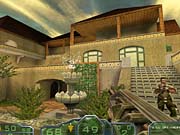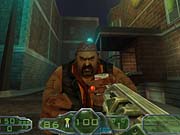After more than five years in development by a small, independent team, Gore should be given credit for getting released at all. A first-person shooter, it also has one interesting idea: power-ups that explode when shot, effectively eliminating the ability to camp them during deathmatches. Beyond these two points, however, there isn't much about Gore that's especially noteworthy. It's neither bad enough to elicit much scorn, nor good enough to generate any real interest. It's a just passably competent old-school shooter that sets its sights pretty low and then manages to hit that mark.

The single-player game is largely forgettable. Like Serious Sam, Gore is a conscious throwback to the stripped-down, fast-paced, generally plot-free action of Doom and the first two Quakes. Unfortunately, Gore is no Serious Sam. It's significantly less inventive. It doesn't look as good. Its combat is less tactical and less intense. It's shorter. And at a retail price of 30 bucks, it doesn't even qualify as a budget title.
The single-player campaign appears to be cobbled together from slightly reworked versions of the game's multiplayer levels, and it shouldn't take more than five or six hours to complete. It's a completely linear and straightforward run through a greatest-hits collection of commonly used shooter locales. There's a space station, a warehouse, a neon-lit urban environment, a dungeon, a Central American temple, a South American drug lord's mansion, an office, and the classic big, empty cathedral/castle with lots of stained glass. Bucking tradition, Gore also includes a Wild West town and a haunted mansion. This variety would have worked better if Gore's graphics were more impressive. The custom rendering engine produces visuals that have more in common with Quake II-powered games than more-recent Quake III and Unreal titles. There are no large outdoor scenes, and most of the action takes place in corridors or tightly bound courtyard areas.
Gore has around eight distinct enemy types, though some of them have multiple weapon loadouts. Most of them are traditional video game "punks." There's the karate guy, the spiky-blond-haired guy, the fat bruiser, and the leather-clad dominatrix. There's also a terminator robot, a guy in a robot suit, and a spawning, chain saw-wielding skeleton that usually appears in packs of five. The AI seems to be rigidly pattern-based: Enemies will run straight at you or stand back and shoot. As Serious Sam proved, simple behaviors can still provide an interesting challenge if those behaviors are varied and complementary and if the enemies attack in large numbers. Gore fails on both of these counts. The behavior mixture isn't well designed enough to promote much logistical complexity, and there are rarely more than five or six opponents in any given battle.
One unique aspect of the character models is that armor actually appears on and protects the part of the body that it's supposed to. For instance, you can target a piece of chest armor, and it will deteriorate and then burst apart as you damage it.
Like most things in Gore, the sound effects are not bad while at the same time being completely unmemorable. The enemies do have an annoying habit of screaming the same few catchphrases over and over again, however.

The first thing you'll notice about Gore's multiplayer game is that it's really fast paced. Player-movement speed appears to be faster than in the original Quake, Daikatana, and even the most recent Gore demo. It offers class-based deathmatch, team deathmatch, and capture-the-flag modes. There are also four "tactical" gameplay types: assault, which is like the recent Soldier of Fortune II's infiltration mode; extermination, a last-man-standing game; escape; and an escort-the-VIP mode called infiltration. There's a built-in server browser, though it doesn't support sorting the list by its various columns. With about 22 weapons, a frantic pace, a nice variety of levels, and what seems to be decent, stable net code, Gore's multiplayer game is certainly not bad. However, at the moment (a week after its release) there's virtually nobody playing online. There aren't a whole lot of servers, which wouldn't be so bad if those few servers had a good number of people playing. Unfortunately, they're just about empty at all times. Unless things change dramatically over the next several weeks, you'll have a difficult time finding a decent match online.
Gore is a decent game, but there isn't anything here that hasn't been done already--and better--in a game you probably already own.